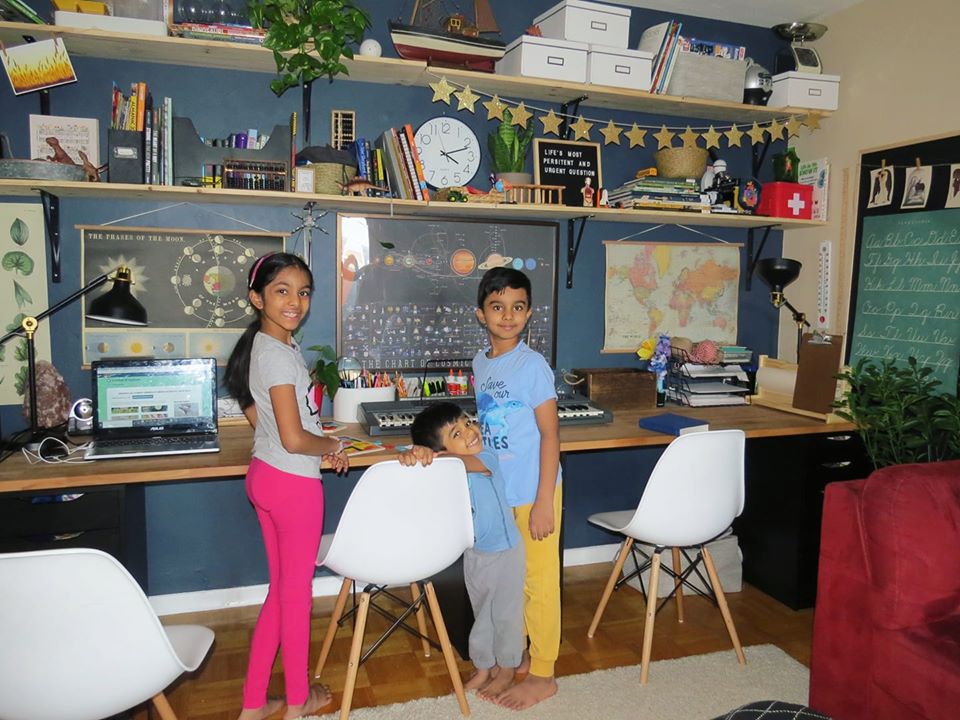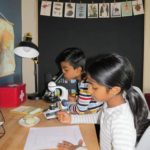With schools and daycares being closed due to COVID-19 for the past couple weeks, I’ve been getting a lot of messages in regards to homeschooling and activities to keep the kids busy at home. Truth be told, I haven’t been on Instagram much because I’ve been taking the time to be more present with my kids. We have the opportunity to slow down from our usual fast-paced lifestyle, and I plan to make use of it while I can by doing activities that we may not otherwise get the time to do. Below I’ll be sharing some of the resources that I have come across and some of the activities that I am/will be doing at home now that the kids have their weekends free from all their usual extra-curriculars.
1) Practice yoga. Yoga is a great way to get our bodies moving and clear our minds. Cosmic Kids Yoga on YouTube offers many engaging yoga videos for kids of all ages. If like us you prefer to practice yoga quietly without the distraction of a TV, I highly recommend learning the 12 poses of the Surya Namaskar or Sun Salutation.
2) Keep a gratitude journal. Start off each day with three things you are grateful for and if willing share them with each other.
3) Make homemade playdough. There are so many different recipes on the Internet for homemade playdough. We tried out a recipe of 1 cup of cornstarch and 1/2 cup of lotion to make a really smooth, soft playdough. Take it one step further for older kids and have them write down a formal procedure complete with purpose, materials, and steps.
4) Start seedlings indoors in an old cardboard egg carton. Once the weather is warmer, cut the individual cups and plant them directly into the soil. In the meantime, let kids record their observations every day and keep in mind that you won’t see sprouts for at least 10-14 days.
5) Learn cursive writing. There are so many affordable cursive writing workbooks available on Amazon or Staples, which can be shipped directly to you. Currently Staples offers both free delivery with no minimum order as well as curbside pick-up.
6) Practice math skills on math-drills.com.
7) Invest time in caring for plants in the home. Get your kids to help dust leaves, fertilize plants as Spring approaches, repot plants, journal changes/growth. If you don’t have any plants, this might be a great time to purchase some. Blue Blossoms offers a variety of unique houseplants as well as contact-less drop off within the GTA for a limited time.
8) Wash produce. Kids love water play and what better way to make use of that than to get your kids to help you wash, dry, and store all your fresh produce. Make sure to wash your vegetables and fruits in a vegetable wash or a simple homemade water and vinegar mixture.
9) Learn to make bread from scratch. If you are like us, we have completely stopped buying fresh breads and baked goods due to COVID-19. Instead we are trying out various recipes for breads and making lots of healthy muffins.
10) Make homemade yogurt. Yogurt is surprisingly easy to make at home and a great afternoon activity to do with the kids. Tamil Food has a recipe up in her highlights on Instagram. Take it one step further and have older kids write out the recipe in their own words.
11) Start a new chapter book series. You can refer to this post for some great titles.
12) Take a virtual tour of some of the world’s greatest museums through Google Arts and Culture.
13) Use a new art medium such as clay or oil pastels or learn a new art technique. Waves of Colour has a cool new string painting technique up on her Instagram feed.
14) Play board games or learn to play a new board game or two as a family. My kids, ages 3 – 9, love Snake and Ladders, Pictionary, Guess Who, Connect-Four, Five Second Rule, and Candyland.
15) Check out The French Experiment for free French resources and free children’s stories in French.
16) Start a new documentary series on Netflix. My kids love animals, so we have watched Our Planet, 72 Cutest Animals, Blue Planet, Frozen Planet, and recently Night on Earth. The kids learn so many cool facts and tidbits of information. Following each episode, we take the opportunity to discuss the episode and following the documentary the older kids write down a summary in paragraph form.
17) Watch Magic School Bus episodes on Netflix.
18) Make popcorn on the stove. Again, this is a great opportunity to follow up with some procedural writing.
19) Pickle something – perhaps cucumbers, carrots, limes, or mango.
20) Write (or draw) and mail out letters to school friends or the grandparents. If you are trying to avoid the post office, opt for emails instead. This is a great way for kids to learn proper letter writing format, as well as to type on a keyboard if sending emails.
21) Try out family meditation. Or at least take a few minutes out of the day to calm down, relax, and take in deep breaths.
22) Grab a journal and go on a nature walk (in a safe but isolated area of course). Use the journal to jot down or draw signs of Spring or anything else that catches the eye.
23) Visit Khan Academy for free schedules and resources for kids aged 2-18. Khan Academy offers free lessons in math, science, and the humanities and kids can make use of available lessons, quizzes, and instructional videos to master skills.
24) Visit the Scholastic website for 21 days worth of home-learning resources for kids Pre K – Grade 9.
25) Practice scissor or knife skills, with supervision of course.
26) Meal plan together as a family, and have the kids design weekly menus to stick onto the fridge.
27) Decorate the home for Spring. We recently set up a Spring-themed tea station to replace Winter’s Hot Chocolate Bar.
28) Make eco-friendly bird feeders with old toilet paper rolls covered in peanut butter and then rolled in birdseed, to hang in the backyard.
29) Paint rocks for your garden or make markers for the garden with popsicle sticks or old wooden spoons.
30) Work on typing skills.
31) Make a paper mâché project such as a model of the solar system. All you need is white glue, water, and strips of old newspaper to make your paper mâché.
32) Watch Cincinnati Zoo’s Home Safari on FB Live daily at 3PM.
33) Prep soups for the freezer. Broth-based soups are easy to make and even easier to freeze. Kids can help wash and cut all the ingredients and add them to the pot. Another prep idea, which requires no cooking – making smoothie packs for the freezer!
34) Visit the Ontario Science Centre website for DIY experiments, science activities and resources or opt to watch the three different family-friendly films available here. Each film is supplemented with a downloadable educational guide.
35) Complete a word search or even create your own word search using thewordsearch.com. When creating your own word search, include spelling words or base the search on an educational theme.
36) Identity common local birds and try to spot them on nature walks. Two books we love, that come with an audio feature to help little ones recognize the bird calls of 12 common North American birds, can be found on Amazon.
37) Learn a language or continue learning French with the Duolingo App.
38) Learn to use a dictionary or create your own personal dictionary with commonly used/misspelled words to use when writing.
39) Organize and put together a home medical/safety kit.
40) Create and test out a recipe or stick to something more simple like making pizza from scratch.
41) Check out the free 7 day trial over at Britannica Kids; an online, interactive encyclopedia. It is not only filled with articles suitable for three different reading levels but also is kid-friendly and ad-free.
42) Work on a jigsaw puzzle together as a family. Do a bit each day as to not feel overwhelmed.
43) Learn to make a paper airplane or boat or simple origami.
44) Conduct family friendly science experiments such as a baking soda and vinegar volcano, DIY lava lamp with coloured water and baby oil, or a simple circuit. KiwiCo. has a few easy kitchen science experiments available here.
45) Make use of free websites like starfall.com for preschool-Grade 3 math and phonics.
46) To keep kids active indoors, check out P.E with Joe Wicks on YouTube every morning at 9 AM.
47) Learn kid-friendly styles of poetry such as acrostic poems, Haikus, rhyming poems, limericks, and cinquains.
48) Learn to accurately use a kitchen scale, dry measuring cups and spoons, and liquid measuring cups.
49) With your preschoolers and kindergarteners, choose to learn about a letter a day. Trace the letter and talk about or draw pictures that begin with the letter of the day.
50) Conduct weekly spelling tests or if you have younger kids work on memorizing sight or Dolch words. Dolch words are 220 words that occur frequently in reading but cannot be sounded out. You can find a list of these words here.
51) Sharpen up math skills/understanding with the Elephant Academy App. Although not free, it is a great app for pre-schoolers as well as older kids).
52) Visit the Nelson website for Math, English, Science, and Social Studies resources that you can download and print for free until June 30th 2020.
53) Write something every day: An alphabet letter for preschoolers, his/her name or one sentence for kindergarteners, and a journal entry, poem, or paragraph for Grade 2s and above. Whatever it is, keep writing.
54) Learn how to effectively use the Internet for research and work on collecting and presenting your research findings. Easy topics of choice: your child’s favourite animal or a country they would like to visit or know more about.
55) Learn to paint with acrylic paint, from the comfort of your own home, with Paint Lounge’s free online Live workshops.
Although I just shared a bunch of resources and activities, don’t feel overwhelmed or obligated to do them all. These are merely ideas to keep your kids learning and growing while they are away from school based on what I do with my three kids. Although we all want our kids to keep up with their academics, do keep in mind that there is so much more to learning than just math and language. Do make time for activities that bring joy, especially at this time of uncertainty.





Could you please post a picture of your tea station would love to see it.